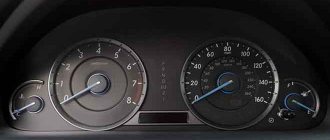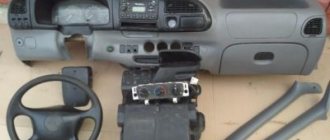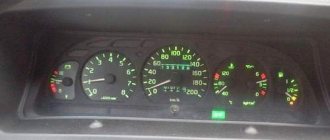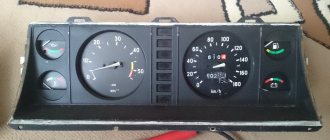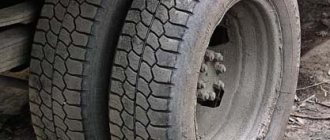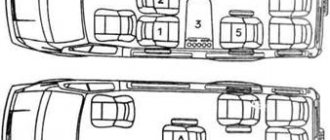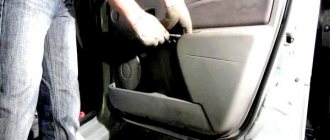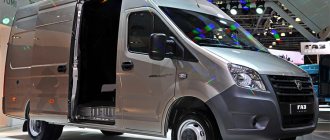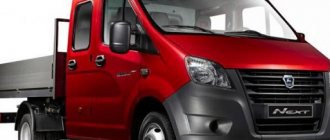GAZelle Business differs from the basic GAZelle modification by increased reliability during operation and an increased service interval (up to 15 thousand). Factory warranty until major overhaul is 80,000 km. or two years from the start of operation, whichever comes first.
The vehicle is positioned as a front-engine, rear-wheel drive (all-wheel drive) minibus for transporting goods. The standard equipment is not rich, as the model is in the budget segment.
To increase comfort and improve a number of technical characteristics, some car owners practice cosmetic tuning. The upgrade is done both on their own and by turning to workshops for help.
What is the difference between GAZelle Next and GAZelle Business and what to choose
The fact is that “Business” has proven itself excellent both in city traffic jams and in off-road conditions in the outback. It is distinguished by good driving performance, functionality and decent load capacity for its class. What do the GAZelle-Next developers offer us, besides a new design? Is this car really a class higher and more comfortable than the previous model? Or should the buyer choose an already proven and reliable “Business”? The main differences between the GAZelles “Next” and “Business” will be discussed in this article.
Body
Let's start with the appearance. The GAZelle “Next” cabin features an original design , with a stylish grille and modern-shaped headlights. It is safer than the Business cabin, as it is equipped with airbags and seat belts for the driver and passengers. Inside the cabin is spacious and comfortable. The driver's seat is adjustable in several directions, and the armrest can also be raised or lowered to the desired height. The instrument panel looks attractive and is convenient; the cabin has compartments for tools and a fire extinguisher. The cabin is equipped with an electric window, heated mirrors and many other small but convenient innovations.
GAZelle Next
Depending on the configuration, the GAZelle “Next” cabin can have a double row of seats that can accommodate 7 people, including the driver. At the same time, the rear row of seats has its own doors, which is convenient for boarding and disembarking passengers.
Gazelle Business
As for the dimensions of the car, they also differ. For the “Next” model they are:
While the dimensions of “Business” are somewhat different: width 1.97 m, height 2.5 m, and length can vary from 3 to 6 meters. The frame for these models is the same.
Sun visor for windshield
The standard visor inside the cabin is not enough to fully protect the driver from ultraviolet rays and blinding. Installing a visor will allow you not to lose control of the road and not be distracted by searching for protection from the sun.
Installation is carried out using double-sided tape. Before gluing, carefully treat the rubber surface, remove dust and dirt, press the plastic, and hold for 2 - 3 minutes.
The price of the accessory is from 560 – 600 rubles, cheaper analogues from 400 rubles.
No. 2. "GAZELLE NEXT"
With the launch of the GAZelle NEXT in the all-metal van (TSMV) version, GAZ Group filled the gap in its model range, thereby ensuring its full competitiveness in relation to the main foreign players. It is the CMF that we will consider in our material. At the time of writing, GAZ had launched the GAZelle NEXT van on the market in two lengths, with two engines and three versions: van, combi and minibus. To this list we must add the three available configurations. And this is not the final decision. The plans are to “play” with the base, roof height and the addition of gas-powered engines.
In our case, there was a Cummins diesel engine under the hood
Why was the usable volume of 13.5 m3 initially chosen? Firstly, to establish itself in the all-metal van market, which was previously dominated by imported models. Secondly, in order not to create unnecessary competition for our own product in the form of “GAZELLE BUSINESS”. By the way, the latter will be produced as long as there is demand for it.
As already mentioned, the useful volume of the most popular cargo van is 13.5 m3, which is 30% more than that of the previous generation GAZelle vehicles. Convenient access to the cargo compartment makes loading and unloading the vehicle as easy and quick as possible. The rear doors are locked in an intermediate position - at an angle of 90 degrees and when fully opened to 270 degrees, giving the carrier freedom of action even in confined urban spaces. The upholstery of the side walls of the van is made of fibreboard, and the floor covering is made of special waterproof and wear-resistant plywood to protect the surface of the body from abrasion and damage. A set of 10 lashing eyes allows you to securely secure the load. Among the innovations, it is worth noting a special hatch under the passenger seat, which allows you to transport long items up to 5 meters long. The small space above the cab can also be used for small and lightweight cargo. In passing, we note that with the help of a forklift, four Euro pallets can be easily loaded into the back of the van.
The GAZelle NEXT body is made of galvanized steel, and individual elements are made of high-strength fiberglass. This provides a long service life and good anti-corrosion properties of the car. The use of a new plastic fuel tank, the volume of which has increased to 79 liters, has made it possible to increase the range per fill-up. Amplifiers introduced into the frame made it possible to increase the strength and reliability of the entire vehicle structure.
This is what a hatch for a long length looks like
We have already written about the spacious and comfortable driver’s cabin in our material about the on-board GAZelle NEXT. Let us only remind you of a seat with five degrees of adjustment, excellent visibility from the driver’s seat, a lot of all kinds of shelves, supports and other everyday “small things”, without which a modern car is simply unthinkable. The power window servo is in the base. A 2 DIN multimedia infotainment center can be installed. As is now customary, there is also an extensive list of additional equipment.
Rack and pinion steering with hydraulic booster, double-wishbone independent front suspension, and a braking system with a good margin of efficiency provide excellent handling and a good level of comfort.
At the moment, cars are equipped with either a Cummins ISF diesel engine in two power versions, or an A27400 Evotech gasoline engine. Engine modifications adapted to run on gas are on the way.
Spacious cargo compartment allows both riggers and loader to work freely
In passing, let’s mention the deeply modernized gearbox and rear axle. Their installation made it possible not only to increase the reliability of the units, but also to increase the transmitted torque to 330 Nm. In particular, the use of bearings with increased load capacity from SKF, Hoerbiger synchronizers, Rubena and Simrit sealing cups, an increase in the width of gears, and the introduction of an intermediate support for the secondary and intermediate shafts will make it possible in the future to use the new gearbox even on a five-ton vehicle.
The original design of the rear suspension, which includes a new suspension and modern Mando shock absorbers with a modified mounting pattern, provides increased road stability and smooth operation of the unit when the vehicle is fully loaded.
Instrument cluster 3110.3801000-90 for GAZ vehicles. Pinout.
Many car owners of a gazelle or Volga car with an old-style instrument panel strive to replace it with a new-style instrument panel, in which most of the indicators have been replaced with modern LED ones, and such an instrument panel looks much more attractive and brighter. But there’s just one problem: you won’t be able to change the instrument panel one-on-one. Either half of the indicators will not light up, or, on the contrary, extra indicators will light up. Let's figure out how to install a new type of instrument cluster (panel) 385.3801-10 instead of the old panel with light bulbs 384.3801-10, which has served for many years. To begin with, let us present to your attention a combination of instruments of the old and new models.
In our case, we changed the instrument cluster on a Gazelle car with a ZMZ 405 Euro-2 engine and a Mikas 11 control unit. If you just take and install the instrument cluster without modifying the wiring, then our combination will work halfway. What will not work or work incorrectly:
CHECK ENGINE indicator will not work (the indicator does not light up when the ignition is turned on) – Instrument cluster backlight does not work – LCD indicators do not function – EBD indicator lights up – ABS indicator lights up – Low beam indicator does not light up when it is turned on
Why is this so, you ask. It’s just that the wiring connectors do not have the necessary contacts for the combination to work properly. Let's look in more detail at what contacts we need are missing, but first, let's give an example of the pinout of the old-style instrument cluster 384.3801-10
| 3 | Grey | signal from the sensor | |
| 4 | White | ||
| 5 | Green | minus | |
| 6 | |||
| 7 | Blue | minus | |
| 8 | |||
| 9 | Orange | signal from the sensor | |
| 10 | |||
| 11 | Red | signal from the sensor | |
| 12 | |||
| 13 | Violet | To fuel level sensor | signal from the sensor |
Engine
Business cars most often have an 8-valve engine produced by UMZ. This engine is easy to maintain and familiar to domestic consumers. As for power and efficiency, the Cummins ISF diesel turbocharged engine, which is installed on the GAZelle “Next”, surpasses the engines of the Ulyanovsk plant in these parameters. Since 2015, Next has also been equipped with a UMZ-A274 Evotech 2.7 gasoline engine, which is an alternative to a diesel engine.
The cooling of the GAZelle “Next” engine is more advanced compared to the “Business” one. The new model has an increased radiator area, which protects the car from overheating. This is especially true in urban environments, where the car is often stuck in traffic jams.
The gearbox of the models in question is identical. This five-speed manual transmission has proven itself over the years.
Front bumper body kit
The installation process is quite simple; no special skills are required. Before gluing the plastic, carefully treat the surface, clean it from dirt, dust, and moisture.
Apply silicone glue and double-sided tape to a dry surface, apply the body kits, and press. We hold it carefully for 2 - 3 minutes, and by analogy we paste over the remaining sections of the bumper.
Provided that the work is carried out with high quality and the recommendations are followed, the guaranteed service life is 5 years until re-pasting.
Price of plastic linings: 950 – 1200 per set, cheaper analogues from 650 rubles.
Seven competitors of Gazelle-Next
The Russian automobile market can be called very saturated - buyers can choose products from dozens of manufacturers, both domestic and foreign. And it is diversity that often becomes an obstacle when choosing - it is impossible to find a vehicle that would be ideal in all aspects. It takes a long time to compare different options based on many parameters, doubt and waste a lot of time.
If the ideal is unattainable, then when buying it is best to focus on a car with balanced characteristics. This is exactly what its creators intended the Gazelle-Next to be - it was developed as a commercial vehicle that exactly met the needs of the Russian market. In order to find out whether this is so, it is worth knowing which cars the domestic product can compete with by selecting alternative options based on various characteristics.
No. 1. IVECO Daily
The Italian Car and Gazelle Next are among the few vans that can boast a very large cargo compartment capacity. For a Russian vehicle it is 13.5 cubic meters, while for IVECO in the version with the highest roof, medium wheelbase and extended rear overhang it is 13.4 cubic meters.
Such indicators allow cars to easily cope with the transportation of bulk cargo that has a relatively low specific gravity. Such characteristics make them an optimal option for use in grocery retail, as well as for delivery services. In addition, the largest modifications of vans are often purchased by construction and installation teams involved in finishing work, insulating houses and other operations. The advantages of a larger volume body can be listed almost endlessly, but in general we can conclude that it makes the car universal and suitable for use in several dozen industries at once.
An Italian competitor with a similar body volume has its advantages, but before choosing it, you should take into account the cost of such a vehicle - about 2 million rubles in the basic configuration. At the same time, the all-metal Gazelle-Next van costs the buyer almost 2 times less. It is worth noting the fact that most IVECO Daily supplied to our country with such a body have a total weight of 5.2 tons - this automatically imposes a restriction on entry into the center of large cities, and also requires obtaining a class C license.
No. 2. Mercedes Sprinter
In construction practice, it is often necessary to transport very long but light objects - for example, cornices, metal profiles and guides, as well as elements of finishing structures. When it comes to cargo with a length of about 5 meters, then most standard vans are powerless - their owners have to rent larger vehicles, or leave the body doors open, violating the Rules and endangering others.
But this problem does not apply to the Mercedes Sprinter and Gazelle Next - they are easily able to cope with these tasks. The German car, in a version with a maximum wheelbase length and an increased rear overhang, can accommodate structures up to 4.7 meters. But Gazelle has surpassed this recognized leader of the European market - a folding hatch in the partition with the cabin allows it to transport 5-meter loads! This means that there is no need to hire heavy transport, spending huge sums on its rental, fuel and loading and unloading operations.
This feature makes the vehicles suitable not only for builders, but also for service companies or advertising agencies - long bodies are convenient for transporting multi-section ladders and stepladders, as well as structures to be installed. In addition, the large maximum cargo length will certainly be of interest to specialized enterprises that sell and deliver large-sized products.
Steering, brakes
How does the GAZelle “Next” brake system differ from its predecessor? First of all, these are anti-traction and anti-skid systems, which provide more effective braking and safety. In addition, “Next” has the following differences:
- Enlarged Bosch brake master cylinder.
- Improved hydraulic booster.
- High-quality brake discs with resistance to high temperatures.
Thanks to this, the braking distance of the GAZelle has been significantly reduced and is only 33 m at a speed of about 80 km/h.
The steering of the GAZelle “Business” and GAZelle “Next” is equipped with power steering, which allows you to put less effort into driving the car. Otherwise, the control system of these machines is completely different. The “Next” has a steering rack, like on a passenger car, which makes driving more comfortable.
What to choose?
As we can see, there are much more differences between the considered models than common characteristics. GAZelle “Business” and GAZelle “Next” differ in all main parameters: engine, suspension and appearance. The control and brake systems have undergone significant changes. The interior of the Next is very different from the previous model, and is more reminiscent of a small foreign-made truck. At the same time, GAZelle “Business” is distinguished by the practicality and reliability of all elements. At the same time, it is also quite comfortable and maneuverable.
If you are faced with a choice of which model is better to purchase, consider first of all the operating conditions of the car, as well as how much time the driver plans to spend behind the wheel.
Various tuning Gazelle Business, prices
Options for improving GAZelle Business:
- installation of plastic body kits on the front bumper;
- replacement of the standard bumper;
- installation of a sun visor on the windshield;
- tinting film on side windows;
- covering the cabin with foil noise-insulating film;
- replacement of standard seats;
- installation of armrests;
- covering the torpedo with fabric;
- connecting a 7-inch display;
- installation of a berth.
